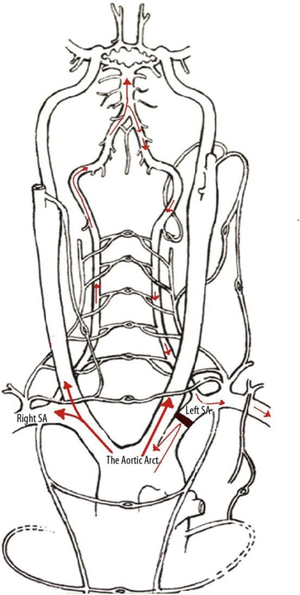We need you! Join our contributor community and become a WikEM editor through our open and transparent promotion process.
Subclavian steal syndrome
From WikEM
Contents
Background
- Stenosis of the subclavian artery, proximal to the origin of the vertebral vessel, results in decreased perfusion pressure to the distal subclavian artery, leading to retrograde flow in the ipsilateral vertebral artery with exercise of the ipsilateral arm. In short, the arm steals blood flow from the vertebrobasilar system resulting in neurologic and upper extremity symptoms due to arterial insufficiency. [1]
- Increased incidence of left-sided subclavian stenosis
- The presence of collateral blood supply is the main determinant of which patients develop neurologic symptoms
Etiology
- Atherosclerosis
- Thoracic Outlet
- Congenital Anomalies
- Takayasu arteritis
Clinical Features
Symptoms in Upper Extremity
- Pain
- Fatigue
- Coolness
- Paresthesias
- Numbness
Neurologic Symptoms
Differential Diagnosis [2]
Shoulder and Upper Arm Diagnoses
Traumatic/Acute:
- Shoulder Dislocation
- Clavicle fracture
- Humerus fracture
- Scapula fracture
- Acromioclavicular injury
- Glenohumeral instability
- Rotator cuff tear
- Biceps tendon rupture
- Triceps tendon rupture
- Septic joint
Nontraumatic/Chronic:
- Rotator cuff tear
- Impingement syndrome
- Calcific tendinitis
- Adhesive capsulitis
- Biceps tendinitis
- Subacromial bursitis
Refered pain & non-orthopedic causes:
- Referred pain from
- Neck
- Diaphragm (e.g. gallbladder disease)
- Brachial plexus injury
- Axillary artery thrombosis
- Thoracic outlet syndrome
- Subclavian steal syndrome
- Pancoast tumor
- Myocardial infarction
- Pneumonia
- Pulmonary embolism
Evaluation
Physical Exam Findings
- Supraclavicular bruit, thrill
- Systolic BP in ipsilateral brachial artery is reduced compared to opposite side
- Ipsilateral radial pulse with decreased amplitude and delayed arrival
Diagnostic Tests [3]
- Routine testing for atherosclerosis: Lipid panel, Glucose
- Doppler ultrasound
- CXR, ECG
- CTA, MRA
- Angiography
Management
Medical Management
- Treat atherosclerosis
- Antiplatelet therapy
- Anticoagulant therapy
Surgical Management
Indicated for symptomatic patients
- Angioplasty with endovascular stenting
- CEA (in patients with associated carotid stenosis) by increasing collateral blood flow
- Surgical bypass
Disposition
- If symptomatic, admit with consults to Vascular Surgery, Neurology
- If incidental finding, consider close outpatient follow-up
References
- ↑ Potter BJ, Pinto DS. Subclavian steal syndrome. Circulation. 2014; 129(22):2320-3.
- ↑ De Lorenzo R. Syncope. In: Marx J, ed. Rosen's Emergency Medicine. 8th ed. Philadelphia, PA: Elsevier Saunders; 2014: 135-141.
- ↑ Berguer R, Higgins R, Nelson R. Noninvasive diagnosis of reversal of vertebral-artery blood flow. NEJM. 1980; 302(24):1349-51
Authors
Carolyn cutler, Ross Donaldson, Neil Young, Claire, Devin Smith

